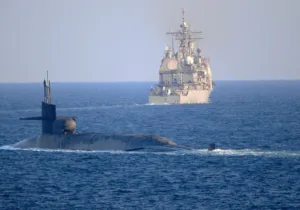On December 3, the US Navy destroyer Carney engaged and shot down several Houthi-controlled drones during a series of missile and drone attacks in the Red Sea on three commercial vessels connected to fourteen different nations. This incident and several others come just days after the Carney shot down another drone while escorting a US oiler and a US-flagged commercial ship in the region. While the United States is set to launch a multinational commerce protection task force in the Red Sea, a potential US response to the attacks has received caution from Saudi officials and criticism from non-interventionists at home, with the oft-outspoken Libertarian Party’s Mises Caucus declaring on X (formerly Twitter) that “US warships should not be in the Red Sea.”
Though non-interventionist idealism doesn’t represent a major influence on US policy-making, Secretary of Defense Lloyd Austin expressed anxieties about non-interventionism in a speech at the Reagan National Defense Forum on December 2, stating that isolationists “in every generation … try to kick loose the cornerstone of American leadership,” and stressing that “global security relies on American unity.” While the merits of various US interventions are matters of careful debate, the US Navy’s current actions in the Red Sea are fulfilling its original role in defending national commerce.
From the very foundations of the Republic, maritime commerce has been perceived as a potential spark for conflict. In Federalist No. 4, John Jay outlined his concerns over America’s vulnerability to foreign threats and the inability of a decentralized government under the Articles of Confederation to effectively respond. Friction between the United States and the great powers of Europe on American-used waterways across the globe especially raised alarm. Jay knew that other nations would view the American prowess in “navigation and the carrying trade,” especially to India, China, and along the Mississippi River as a commercial threat, believing that it would “be more [foreign powers’] policy, to restrain than to promote it.”
Jay’s co-author Alexander Hamilton shared his concerns in Federalist No. 11, commenting that “the adventurous spirit, which distinguishes the commercial character of America, has already excited uneasy sensations in several of the maritime powers of Europe.” Hamilton then proposed the formation of a federal navy under the new constitution as the solution to this issue. Hamilton’s awareness of maritime threats to the United States culminated in his successful advocacy for the creation of a US Revenue-Marine (a precursor to Coast Guard) in 1791, and a US Navy in 1794.
In the Pacificus-Helvidius debates of 1793-1794 with James Madison over the separation of powers and US neutrality in the war between Great Britain and France, Hamilton placed the young nation’s potential use of its Navy and other forces within a larger foreign policy framework. Arguing in favor of US neutrality, Hamilton asserted that a nation’s “policy regulated by their own interest, as far as justice and good faith permit, is, and ought to be their prevailing policy.” Though thoroughly realist in his attitudes, Hamilton left rare moral exceptions for US intervention abroad when justice and good faith called for a departure from the national interest. This national interest demanded the US Navy’s protection of commerce against the French in 1798, the British in 1812, and several North African states in 1801 and 1815. Even Hamilton’s political rival Thomas Jefferson, notably skeptical of an ocean-going naval force, ultimately came to understand the importance of a navy that could protect commerce far from American shores during his presidential administration.
John Quincy Adams made the greatest strides in promoting a global US Navy dedicated to commerce protection. In his first annual presidential address in 1825, Adams devoted significant time to naval affairs, specifically arguing for an even greater navy role in commerce protection abroad as wars for independence raged in Greece, Chile, and Peru. Adams contended that the “irregular and convulsive character” of these wars created volatile maritime situations “in which the neutral navigation of this Union is always in danger of outrage and depredation.” These wars, coupled with “a flourishing commerce and fishery extending to the islands of the Pacific and to China,” prompted Adams to charge Congress with the maintenance of a “permanent naval peace establishment,” cautioning against a “vain and dangerous illusion to believe that in the present or probable condition of human society a commerce so extensive and so rich as ours could exist and be pursued in safety without the continual support of a military marine.”
Adams and his successors fulfilled his vision for the Navy, extending its reach to a global scale. Presidents from a wide range of political persuasions bought into the idea of commercial protection far from American shores. Andrew Jackson dispatched a naval “punitive” expedition to act against reports of piracy against American shipping off the coast of Sumatra in 1831, while John Tyler essentially extended the Monroe Doctrine to the Hawaiian Islands in 1842 in response to threats of British and French colonization of the independent kingdom; Tyler’s stated reason, the protection of American merchant and whaling vessels, “constituting five-sixths of all which annually visit [Hawai‘i].”
The United States’ current strategic maritime position differs greatly in two ways from that of the early Republic. The US Navy, of course, is now the premier maritime fighting force in the world, no longer needing to punch above its weight against larger global powers. While the navy’s military capabilities have exponentially increased over the last two centuries, the nature of the civilian maritime fleet it defends has also dramatically shifted. While US-flagged vessels carried 92.5 percent of international maritime trade to and from the United States in 1826, American ships carried less than 2 percent of that trade in 2010. The registry and crew nationalities of vessels carrying cargo to and from the United States are varied but, for better or worse, are largely foreign. For the US Navy, this means that to protect American trade is to protect non-American vessels.
Even if one draws a distinction between protecting US-flagged vessels and non-US vessels that travel to and from American ports, the latter still falls under US Naval protection. Rendering aid to civilian vessels under attack from an unrecognized rebel group qualifies as a reasonable exception to Hamilton’s idea of national interest, this assistance being done under his principle of “justice and good faith” without straining US resources. So long as US warships assume their natural role in protecting US-flagged vessels—which continue to travel through the Red Sea—protecting non-US vessels within their area of operations represents a prudent and good faith approach to foreign policy.







 Sponsor a student for Christianity & National Security 2024
Sponsor a student for Christianity & National Security 2024